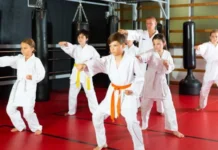There has probably never been a time in history when sanitizing and cleaning has been more high profile than it is right now!
The COVID virus has claimed millions of lives. Studies have shown sanitization and surface treatment are important. To maintain a healthy environment, we have to take sanitizing surfaces seriously.
So what’s involved in cleaning and sanitizing surfaces? What’s the difference between cleaning and sanitizing? How can you make sure that every surface gets the right treatment?
Read on for your ultimate guide to sanitizing and cleaning any surface.
Sanitizing and Cleaning 101: What’s the Difference?
When it comes to keeping homes and workplaces clean, there are three terms that are often used. They are:
- Cleaning
- Sanitizing
- Disinfecting
The terms often get used interchangeably. But actually, they all refer to different things.
Cleaning is the process of removing dirt and pathogens from a surface. Pathogens are harmful germs such as viruses and harmful bacteria that can make us sick.
Wiping away dust or crumbs, or wiping down a surface with soap and water are all examples of cleaning. Notice that cleaning involves removing germs, but does not involve killing them. That’s where sanitizing and disinfecting come in.
Sanitizing is the next level of protection. Many sanitizers claim to kill 99.9% of all pathogens. That’s great, but it’s not total protection, and some are only effective against bacteria.
Disinfecting surfaces removes all the pathogens. This is the level of safety that you need in clinical settings and ideally during the pandemic. Equipment will be sterilized, and surfaces will be disinfected.
Disinfectants that can kill COVID-19 are regulated by the EPA. They maintain a list called ‘List N’. Only products that have been tested and approved are put on this list and should be used for disinfecting during the pandemic.
Why Sanitizing and Cleaning Are So Important
In this article, we’re focusing on sanitizing and cleaning – two crucial steps to keep any workplace as safe as possible. And this is not just of importance during the pandemic.
Keeping your home and workplace clean and sanitized doesn’t just reduce the spread of communicable diseases. It can also boost employee morale and help them to enjoy coming to work. At home, everybody can feel happier and more relaxed in a clean environment.
But before you grab your lemon Joy Soap and get scrubbing, let’s take you through how to sanitize and clean every surface you’ll ever come across.
Routine Cleaning – Key to Keeping Healthy
We all vacuum our homes, wipe down our bathrooms, and mop our kitchen floors. But is there something more that we should do to keep this environment truly healthy?
Most of our routine cleaning probably focuses on removing dirt and grime. In places like the kitchen and bathroom, we easily recognize the danger posed by pathogens from food and the toilet. In those places, we probably focus a little more on sanitizing.
However, to keep our homes and workplaces truly safe, it’s good to have a routine of regularly cleaning and sanitizing all surfaces.
Sanitizing Touchpoints
Touchpoints are places that we touch throughout the day without even thinking about it. For example, light switches, door handles, and shared appliances are all regularly touched by many people.
These surfaces usually look clean. But they could actually be harboring a lot of germs.
Because there isn’t usually any dirt and grime on light switches, start by grabbing a soft cloth. Choose a sanitizer or disinfectant that is approved by the EPA. Then, following the manufacturer’s instructions, gently wipe all light switches.
The same technique can be used for handrails, door handles, and even phones, keyboards, printers, and photocopiers. It’s crucial to always follow the manufacturer’s instructions. Check if it is safe to use on electronics when you apply it to an absorbent cloth first.
In the workplace, sanitizing touchpoints is especially important. This should be done periodically throughout the day for maximum protection.
Sanitizing and Cleaning Hard Surfaces
It’s very important to clean before you sanitize. The process of sanitizing will not remove dirt and grime from surfaces. You usually cannot combine the two.
For cleaning the majority of surfaces, soap and water really are your best friends. Make sure though that the cloth or sponge you are using is clean to start with. Using dirty cloths will only spread pathogens, meaning more work for the sanitizer to do.
How to Clean Hard Surfaces
Cleaning should happen as early as possible. This is about both safety and making life easy. Spills that have dried on are not only a breeding ground for bacteria, they’re also extremely difficult to remove.
It’s good to get into the habit of cleaning up spills and mess as soon as they happen and train everyone in the house to do so. After you have cleaned your hard surfaces using soap and water, you are ready to sanitize.
There are very few surfaces that you can’t clean with soap and water. Leather, cork, marble, and wallpaper are a few obvious exceptions. In each of these cases, you will need to use specialist cleaners to keep them in good condition.
However, for stainless steel, wood, plastic, and ceramic surfaces – all of the most common surfaces in your home – soap and water are your friend. Just remember with wooden surfaces to either dry them quickly or use very small amounts of water on them.
How to Sanitize Hard Surfaces
After you have cleaned away the dust and dirt, it’s time to start sanitizing. Choose an EPA-approved disinfectant. Carefully read the instructions.
The reason we stress this is because some disinfectants need to be left wet for a couple of minutes to do their thing. If you simply spray them and wipe them straight off, they won’t fully sanitize the surface.
This is super important because it’s a waste of money and a health risk if you do not use them properly. Following the instructions gives you peace of mind that you’ve correctly sanitized the surface.
Keeping Floors Clean and Sanitized
Different floors require different approaches to cleaning and sanitizing. But just like surfaces, all of them begin with removing dirt and grime.
In most cases, the most effective way to do this is by sweeping or vacuuming them. Vacuuming can also be effective on hard floors if your vacuum has a hard floor setting. This helps to remove the visible dirt and a layer of dust.
Tile Floors
For tile floors, a traditional mop is much less effective than a microfiber mop. Traditional mops move dirt around the floor. Microfiber mops actually trap dirt and bacteria and allow you to transfer that away from the floor surface.
A combination of an EPA-approved disinfecting floor cleaner with a microfiber mop will offer you the best level of protection.
Steam cleaners can also be an effective method of cleaning tile floors. However, for peace of mind, an approved disinfectant offers the best germ-killing power.
Hardwood and Laminate Floors
Hardwoods and laminates need a little more care. In general, try to keep them as dry as possible. Microfiber mops can be effective because they need very little moisture to work effectively. Use a hardwood floor cleaner that doubles up as a disinfectant.
Carpeted Floors
Small rugs are easy to shake outside and throw in the washing machine with laundry sanitizer. But how do you clean and sanitize large, fitted carpets?
Regular vacuuming is great for keeping them clean, but to disinfect them you will need to use an EPA-approved carpet disinfectant. Vinegar is not an EPA-approved disinfectant.
Use the product along with a steam cleaner. Again, be careful to follow the manufacturer’s instructions, and perform a test in an inconspicuous spot first.
A Word of Warning
EPA-approved disinfectants can help to reduce our exposure to harmful pathogens. However, used incorrectly, they can be dangerous. Always follow the instructions on the bottle.
By all means, get the kids involved in cleaning surfaces with soap and water. But do not allow children or students in the workplace to apply disinfectants. You should also store them where children cannot reach them.
Be very careful never to mix bleach-based chemicals with ammonia-based chemicals. The combination gives off a gas that is poisonous to humans.
Also, remember – double the amount of disinfectant does not equal double the protection. Simply follow the manufacturer’s instructions to get the most benefit from the product.
Cleaning Surfaces When Someone Is Sick
When a family member goes down with one of the many communicable diseases going around, keeping the home clean will protect the rest of the family.
Ideally, keep that person away from the family as much as possible. If they have a separate bedroom and bathroom they can use, that’s perfect. Get them all the supplies they need to keep their environment clean.
If you have to share facilities, set up a schedule for cleaning and sanitizing shared areas regularly. Also, handle the sick person’s dishes wearing gloves and wash them in hot, soapy water.
When they recover, carefully disinfect your home, using the techniques discussed.
The Undeniable Importance of Sanitizing and Cleaning
We understand more than ever the importance of sanitizing and cleaning. Higher levels of care in both areas have doubtless helped us all to stay healthier during the pandemic. These are good habits to continue whatever the future holds.
Remember to always clean before you sanitize. Treating soiled surfaces with sanitizer or disinfectant is not effective. Soap and water are nearly always your first line of attack when cleaning and sanitizing.
We hope that you’ve enjoyed this article, and it can help you and your loved ones to stay healthy and safe. For more great hints and tips, head over to our Lifestyle section today!























